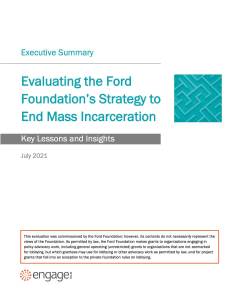Evaluation of Ford’s Mass Incarceration strategy
The Challenge
For too many communities, mass incarceration has become a defining feature of American life. In 2013, recognizing the disproportionate and brutal impact of the criminal justice system on poor, Black and Latinx communities, we built on our years of investing to concentrate our efforts on decarceration, with an emphasis on adult sentencing reform. Beginning in 2016, we set out to deepen our state-level grantmaking on justice reform by focusing on six key states (California, Colorado, Florida, Michigan, Ohio, and Oregon) and two cities (New Orleans and New York), along with investing in national organizations positioned to create momentum for change across the country.
What We Did
Over the past five years, our strategy has been focused on identifying new models of justice reinvestment, supporting sentencing reform policies and practices, and increasing government investments in crime prevention and public health programs in communities most impacted by mass incarceration.
To date, Ford has invested $47 million to fund 50 grantees, ranging from grassroots, legal, and policy organizations in priority states and cities to well-established advocacy, research, and media nonprofits with national scope. Together, they are working to:
- build a strong base of affected constituents to increase pressure for reforms
- develop and advance policy campaigns
- design and implement innovative alternatives to incarceration
- increase government funding for upstream approaches to community safety and health
- strengthen the capacity of the movement to drive change
In 2020, we partnered with Engage R+D to assess the progress of our efforts to end mass incarceration, generate insights, and identify areas to advance our work.
What We Learned
1. Big wins required a combination of strategies, but generally led with one or two.
State legislative reforms in Michigan, for example, led with a sophisticated policy campaign and teamed up with elected officials, and built on the stories of formerly incarcerated people to highlight injustice in the criminal justice system and reinforce their case.
2. Jail closure and reinvestment required a well-organized base and a progressive political environment.
The push for the closure of New York’s Rikers Island Jail Complex and Los Angeles’ Men’s Central Jail—and the reinvestment strategies that followed—involved a network of grassroots organizations driving the agenda and considerable pressure from constituent-led groups. As one participant reported, “What has worked in those type of laws around [#CLOSErikers], Justice LA, Close the Creek, was [organizers] maintaining in their lane and keeping their foot on the gas pedal.”
3. Coordinating strategies and actors is critical to achieve significant, lasting change.
This kind of coordination might involve internal and external strategies, such as influencing decision-makers through outside pressure in the form of organizing, advocacy, and media work, while also providing research and technical assistance to policymakers working inside the government to sway peers. It might also involve strategic coordination within the movement. Nevertheless, this work requires the ability to navigate very real tensions about what qualifies as a win—and the best way to get there.
4. Involve people who are personally impacted by incarceration.
When shaping strategies and solutions, it is essential to have people with lived experience of incarceration at the table. Change efforts should center their leadership and priorities. Elected officials and others noted that hearing directly from those most impacted can be a powerful way to catalyze change.
5. Messaging matters.
While there was broad agreement about the importance of narrative as a key part of the change process, perspectives differed as to which kinds of messages would be most effective. Some participants favored narratives that emphasized second chances and cost-effective policy, while others favored messages that involved expanding notions of safety. There were also a variety of views on the utility of messages related to police and abolishing prisons, with some questioning the practicality of incorporating these terms into public messaging and others more hopeful about shifts in public discourse.
6. Build a base and cultivate influential allies.
Building a base for deeper, more sustainable change might involve cultivating unlikely but influential allies, including business leaders, the faith community, rural populations, crime survivors, and people within the existing criminal justice system, such as prosecutors, sheriffs, and others likely to have opinions about proposed reforms. Support from unlikely allies can be critical for policy wins in more conservative states and helpful in countering backlash against reforms.
7. Build alternatives and replacements.
There is a need for alternatives and a service infrastructure to support people diverted from jail or prison, or who are transitioning back into the community after incarceration. Without this infrastructure, there is greater potential for re-offenses, which can have a negative impact on sustaining and advancing reforms. In playing the long game, we should also consider more transformative approaches to public safety, and build new models and paradigms.
8. Leverage research and data to demonstrate what works.
Understanding and emphasizing evidence-based solutions is a critical element for advancing change. Equipped with data to inform policy processes (for example, on incarceration costs and recidivism rates), officials can cut through emotions and rely on numbers to back up decisions. Timely, accessible, and comparable research on the effectiveness of different reforms can help address gaps in how people understand what works. And case studies of new and transformative approaches can be used to motivate and support positive change.
